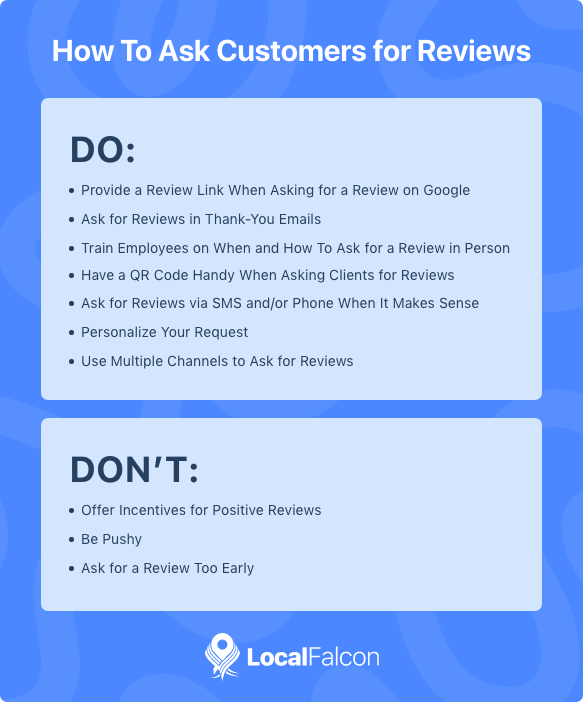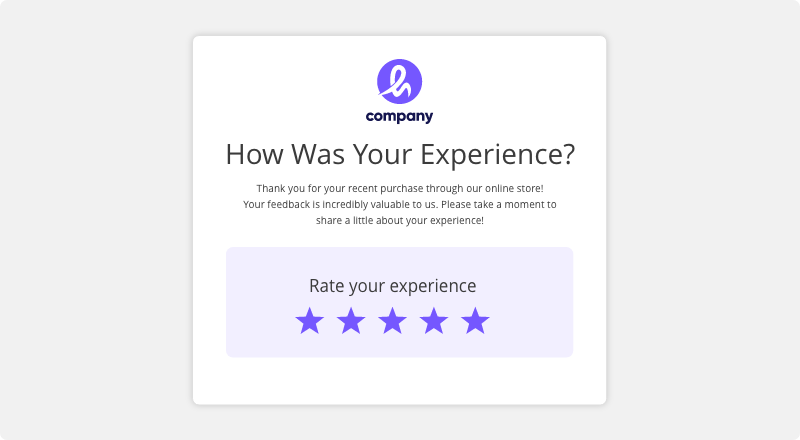Asking customers for reviews is essential to collecting a steady stream of positive reviews to improve local SEO and attract more nearby customers.
But, while asking for reviews may sound like a relatively straightforward task, it's important to follow some best practices related to how to ask for a review after providing customers with products or services. This not only increases the chances of satisfied customers taking the time to leave you a review, but also helps avoid potential issues, such as penalties related to incentivizing customers to leave good reviews.
So, without further ado, here are some of the most important dos and don'ts to keep in mind when asking clients for reviews.

How To Ask Customers for Reviews
1. Do Provide a Review Link When Asking for a Review on Google
When we talk about asking for reviews for local SEO purposes, the most important place to ask customers to leave reviews is on Google, via Google Business Profile. These Google reviews are one of the most important direct ranking factors for local search.
In order to make it easier for customers to leave a review on your Google Business Profile, you should always provide them with a Google review link. You can easily generate a Google review ahead of time and keep the link handy, sending it out to customers in follow-up emails or turning it into a QR code to physically post in your store, for example.
2. Don't Offer Incentives for Positive Reviews
Offering customers an incentive, monetary or otherwise, to leave a review is a big no-no for Google that can potentially result in a Google Business Profile violation and suspension.
Google certainly allows, and even encourages, businesses to ask customers to leave reviews, but soliciting reviews in exchange for some type of reward goes against Google's review guidelines, which exist to help ensure reviews are honest, trustworthy, and helpful.

3. Do Ask for Reviews in Thank-You Emails
Whenever possible, send customers thank-you emails after they make a purchase or receive a service from your business. After thanking them for their business, ask them politely to take a few minutes to leave a review of their experience with your business; and don't forget to include that review link!
Although Google is definitely the most important platform to ask customers to leave a review on, you may also include links to other relevant directories and reviews sites, such as Yelp and Tripadvisor, which can help improve your local search performance on other search engines and apps, like Bing and Apple Maps.
4. Do Train Employees on When and How To Ask for a Review in Person
Asking customers for reviews in person doesn't always make sense in the context of an interaction, but when done at the right time it can be one of the most effective ways to get a glowing review.
The best time to ask for a review in person is when a customer offers up praise, such as commenting on the quality of the food after a meal at your restaurant.
To capitalize on these opportunities, train your employees to prompt these types of interactions by asking little questions like, "How was everything today?" or "Did you find everything you were looking for?" Then, they can respond to praise by asking the happy customer directly if they would mind leaving a review mentioning what they just said.
5. Do Have a QR Code Handy When Asking Clients for Reviews
Turning a review link into a QR code that customers can scan with their phone to instantly leave a review is the best way to ensure customers who you ask for reviews in person leave them before forgetting.
Whenever an employee asks a customer for a review, they should be able to provide them with or point them in the direction of a review QR code that they can scan to leave their feedback.
In a restaurant, for example, this QR code might be inserted into a menu holder on every table. Or, in a retail store, you might have sign holders with QR codes at the cash registers and exits.

6. Don't Be Pushy
When asking for reviews, it's important to strike a balance between being friendly and being overly assertive. Being too pushy can make customers feel uncomfortable or pressured, which can backfire and result in negative feedback (or no feedback at all).
To avoid coming across as pushy when asking customers for reviews, gauge their interest and sentiment first. Instead of diving straight into a review request, look for cues that a customer is happy with their experience. This makes it more natural to segue into asking for a review, whether it's in person or when following up by email or another method.
It's also important to respect customer boundaries. If a customer declines or seems uncomfortable with the suggestion to leave a review, don't press further. It's better to let them walk away with a positive impression than to risk making them feel annoyed or obligated!
7. Do Ask for Reviews via SMS and/or Phone When It Makes Sense
SMS and phone calls can be effective ways to ask for reviews when used thoughtfully, but make sure to only reach out via SMS or phone if the customer has opted in or is accustomed to speaking to you by phone. This keeps your request considerate and well-received.
Use SMS for quick, direct requests, especially for businesses like salons or gyms with customers who have opted into texts for appointment reminders and such. For these types of businesses, a brief, friendly SMS with a review link can encourage feedback.
Use phone calls for high-touch services, like real estate or car sales. For these types of businesses, a friendly follow-up call can feel personal and meaningful, especially if there's already a good rapport with the client.
8. Do Personalize Your Request
A personalized review request feels more genuine and shows that you value the individual's experience. Address customers by name, if possible, and mention specific details about their visit or purchase.
9. Don't Ask for a Review Too Early
Timing is crucial when asking for reviews. Avoid asking for reviews right when the customer is paying or just after their purchase, as it may seem insincere. Instead, wait until they've had some time to fully experience the product or service, or send a follow-up email a day or two later when the experience is still fresh in their mind.
10. Do Use Multiple Channels to Ask for Reviews
Different customers prefer different methods of communication, so don't limit your review requests to just one method. Use a mix of follow-up emails, in-store QR codes, and even social media to give customers several options for leaving feedback. This also helps capture reviews from customers who may otherwise forget if only reminded once.

Conclusion
Understanding how to ask for a review can be incredibly beneficial when it comes to managing your online reputation and improving local SEO while you're at it. By following these dos and don'ts, you'll encourage customers to share their experiences in a way that feels natural, comfortable, and rewarding.
Collecting a steady stream of positive reviews on Google and other relevant platforms will boost your rankings in local search results, help attract more nearby customers, and provide you with valuable sentiment analysis insights that you can use to optimize your business and local search performance.
When asking for reviews, remember to always keep it friendly, make it easy, and focus on creating genuine connections that leave customers happy to share their feedback!

